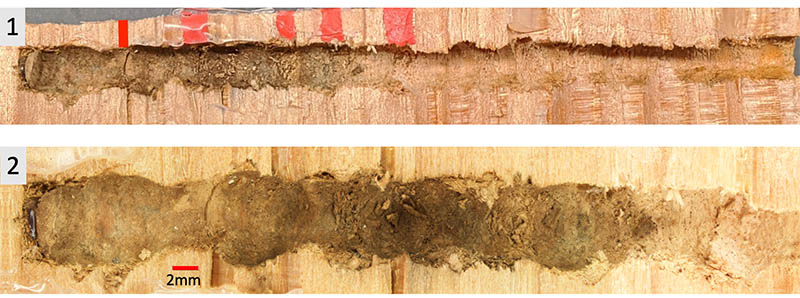Record of Anthophora (Clisodon) terminalis in a wooden trap-nesting block and comparison to available nesting information (Hymenoptera: Apidae)
DOI:
https://doi.org/10.17161/jom.vi99.13315Abstract
Bee nesting substrate choice can influence habitat use, conservation effort efficacy, and population or landscape-use modeling, but information on nesting sites are often scattered in the literature. Here we bring together the available information on nests of a widespread bee, Anthophora (Clisodon) terminalis Cresson, and describe an unusual new nesting substrate use for this species.
References
Ascher, J.S., & J. Pickering. 2019. DiscoverLife bee species guide and world checklist (Hymenoptera: Apoidea: Anthophila) – online edition. [https://www.discoverlife.org/mp/20q?guide=Apoidea_species; last accessed December 2019].
Brooks, R.W. 1988. Systematics and phylogeny of the Anthophorine bees (Hymenoptera: Anthophoridae; Anthophorini). University of Kansas Science Bulletin 53(9): 436–575.
Cockerell, W.P. 1903. The nesting of a carpenter bee (Clisodon terminalis). Birds and Nature in Natural Colors 14: 127–128.
Graham, J.R., E. Willcox, & J.D. Ellis. 2015. The potential management of a ground-nesting, solitary bee: Anthophora abrupta (Hymenoptera: Apidae). Florida Entomologist 98(2): 528–536.
Leonard, R.J., & A.N. Harmon-Threatt. 2019. Methods for rearing ground-nesting bees under laboratory conditions. Apidologie 50(5): 689–703.
MacIvor, J.S., & L. Packer. 2015. ‘Bee hotels’ as a tool for native pollinator conservation: A premature verdict? PLoS ONE 10(3): e0122126.
Medler, J.T. 1964. Anthophora (Clisodon) terminalis Cresson in trap-nests in Wisconsin (Hymenoptera: Anthophoridae). Canadian Entomologist 96(10): 1332–1336.
Michener, C.D. 2007. The Bees of the World [2nd Edition]. Johns Hopkins University Press; Baltimore, MD; xvi+[i]+953 pp., +20pls.
Orr, M.C., T. Griswold, J.P. Pitts, & F.D. Parker. 2016. A new bee species that excavates sandstone nests. Current Biology 26(17): R792–R793.
Rehan, S.M., & M.H. Richards. 2010. Nesting biology and subsociality in Ceratina calcarata (Hymenoptera: Apidae). Canadian Entomologist 142(1): 65–74.
Sladen, F.W.L. 1919. Notes on the Canadian representatives of British species of bees. Canadian Entomologist 51(6): 124–130.
Sheffield, C.S., M.A. Wilkes, G.C. Cutler, & L. Hermanutz. 2015. An artificial nesting substrate for Osmia species that nest under stones, with focus on Osmia inermis (Hymenoptera: Megachilidae). Insect Conservation and Diversity 8: 189–192.
Stephen, W.P., G.E. Bohart, & P.F. Torchio. 1969. The Biology and External Morphology of Bees; with a Synopsis of the Genera of Northwestern America. Agricultural Experiment Station, Oregon State University; Corvallis, OR; 140 pp.
Torchio, P.F. 1971. The biology of Anthophora (Micranthophora) peritomae Cockerell (Hymenoptera: Apoidea, Anthophoridae). Contributions in Science, Los Angeles County Museum 206: 1–13.
Vickruck, J.L., S.M. Rehan, S.C. Sheffield, & M.H. Richards. 2011. Nesting biology and DNA barcode analysis of Ceratina dupla and C. mikmaqi, and comparisons with C. calcarata (Hymenoptera: Apidae: Xylocopinae). Canadian Entomologist 143(3): 254–262.
Downloads
Published
Issue
Section
License
Copyright (c) 2020 Colleen D. Satyshur, Michael C. Orr

This work is licensed under a Creative Commons Attribution-NonCommercial-NoDerivatives 4.0 International License.
Copyright for articles published in Journal of Melittology is retained by the authors, with first publication rights granted to the journal. By virtue of their appearance in this open access journal, articles are free to use, with proper attribution and permission of the authors, in educational and other non-commercial settings.





